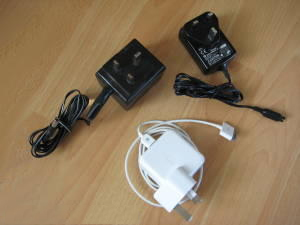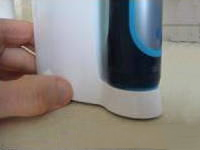Transformers in your home
As we've already seen, there are lots of huge transformers in towns and cities where the high-voltage electricity from incoming power lines is converted into lower-voltages. But there are many transformers in your home too. Big electric appliances such as washing machines and dishwashers use high voltages, but electronic devices such as laptop computers and mobile cellphones use relatively tiny voltages: a laptop needs about 15 volts, and a cellphone needs less than 6 volts when you charge up its battery. So electronic appliances like these have small transformers built into them (often mounted at the end of the power lead) to convert the 110–240 volt domestic supply into a smaller voltage they can use. If you want to know why things like cellphones have those big fat chunky power cords, it's because they contain transformers!
Many home transformers (like the one for cellphones) are designed to charge up rechargeable batteries. You can see how do they work: electricity flows into the transformer from the electricity outlet on your wall, gets transformed down to a lower voltage, and flows into the battery in your phone. But how about something like an electric toothbrush, which has no power lead? It charges up with a little different type of transformer, which has one of its coils in the base of the brush and the other in the charger that the brush stands on.
Photo: Typical home transformers: chargers.

Photo: An electric toothbrush and its base.

Solar Inverter: Working Principle, Benefits
A solar inverter is an integral component of the solar energy system. It gets hold of direct current (DC) energy and converts it to alternating current electricity (AC). If you live in an area where the load exceeds supply or a place that experiences regular outages, you should invest in a solar panel inverter system.
How does a solar inverter work?
The solar panels are made of photovoltaic cells – semiconductor layers of gallium arsenide or crystalline silicon. Once the sun shines, these layers absorb energy from the PV cells. The energy moves between positive and negative layers to produce a direct current. Once the energy gets in the inverter, it runs through the transformer and splits out an AC output. Technically, the inverter tricks the transformer to think that DC is AC. The appliances on your home run on 120/240V AC.
Since solar panels don’t produce energy at night, you rely 100% on the grid. Some inverters can mix the grid power with the energy from the solar batteries.
Benefits of a Solar Inverter
1. Maximize energy production
Solar inverters keep track of voltage to discover the maximum power that the modules can function.
2. Monitoring system output
A solar power inverter generates thousands of watts every day. The inverter offers a way to help you view how much power you’re using.
3. Communicating with the utility grid
If there’s a temporary power outage, the solar power inverter ensures electricity is not transmitted to external power lines. New smart inverters have a way of communicating with the grid. They carry out grid-supportive tasks that relate to frequency, communication, voltage, software, and controls.
The dawn of a new age of HVDC technology
-News from Siemens Challenge
AC can be transported at high voltages from the power plant to consumers with low losses, but this applies only to distances up to approx. 600 kilometers. Over longer distances, high AC voltages have increased transmission losses. Direct current transmission is used instead as a cost-effective way to provide low-loss power supply and to use the electrical energy more efficiently.
HVDC transformers are part of the converter station at the beginning of the transmission line which converts AC to direct current. This process is then reversed at the end of the line. Converting AC to DC helps to transfer the energy efficiently while cutting line losses by 30-50%. As a core component of the Changji-Guquan HVDC line, the tested transformer brings the voltage to 1100kV DC level.
Solution
Siemens completely designed all key components for its 1,100 kV converter transformers from scratch on the basis of many years of experience constructing HVDC transformers. The biggest challenge was the insulation system. For example, both valve bushings through which the current flows from the transformers into the valves are approximately 19 meters long. Overall, the transformers are 37.5 meters long, 14,4 meters high and 12 meters wide. In operation, the transformer weighs 909 metric tons. The efficiency of the converter transformer is well above 99% of the rated power.
Benefits
“With the first successfully tested 1100 kV UHVDC transformer we have demonstrated our industry leading position. Our pioneering transformer technology supports a global power grid, called Global Energy Interconnection. In this way, we are making way for the interconnection of the global ultra high-voltage three-phase grids and ultra high-voltage DC grids on the 1,100 kV DC and 1,050 kV AC level. The innovations being implemented here will benefit our entire product range”, concludes Dr. Beatrix Natter, CEO of Siemens Transformers.






